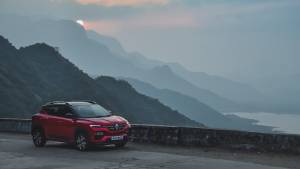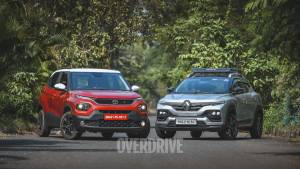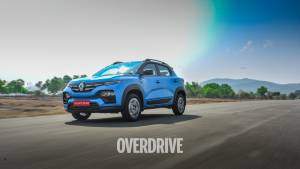Comparison review: Renault Kiger vs Nissan Magnite vs MS Vitara Brezza vs Kia Sonet
If you're looking to buy a compact SUV at the moment, it's but inevitable that the conversation shifts to the value offered by the two newest compact SUVs in India, brought to you by the Renault-Nissan alliance - the Kiger, and the Magnite. Especially considering everything they bring to the table. You've got two brand, spanking new compact SUVs (debuted in India, mind you) with fresh look-at-me styling, a thickly padded features list, and fairly modern powertrains, including turbo-petrol motors and automatic gearboxes.
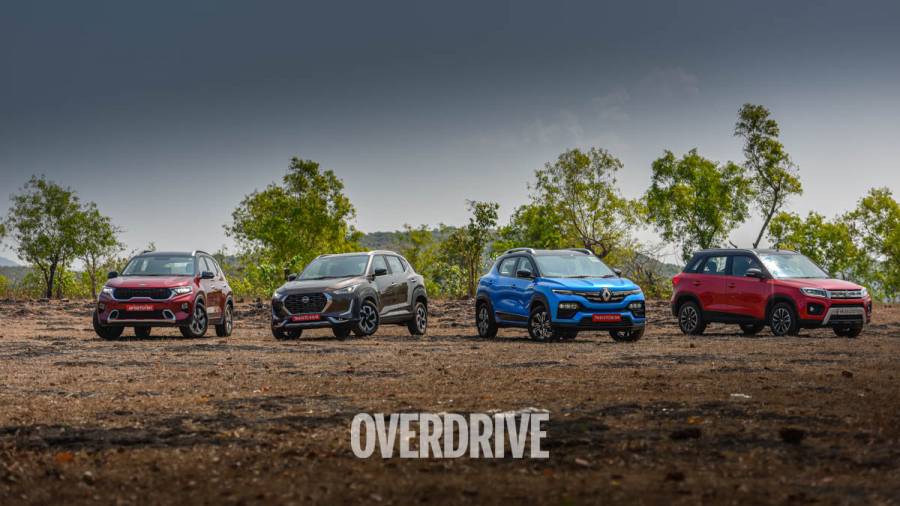
A far cry from the value-centric cars we've got in the past, no? Still, with the compact SUV segment throwing more than a few blockbusters our way, such as the Maruti Suzuki Vitara Brezza, and the more recent Kia Sonet, it begs the question if you can do well enough without spending the extra money - and that's why the Sonet is here, for reference, considering the pricing does put it right at the very top of the segment, and away from being a direct competitor. Still, the answer is surprising, even to us.
Renault Kiger vs Nissan Magnite vs MS Vitara Brezza styling
It seems that with these compact SUVs, styling has gone from classic to futuristic, sacrificing a little of the SUV nature along the way. Between the Kiger and Magnite, the Magnite is marginally longer and wider, but the Kiger is 33mm taller, with both riding on a similar 2,500mm long wheelbase, incidentally the exact number for all the cars here.
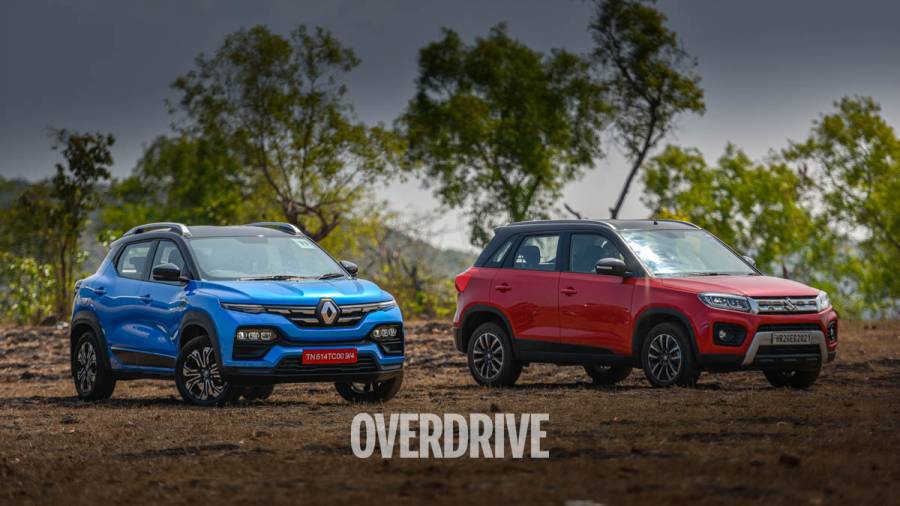
To our eyes, Brezza looks the most like an SUV scaled down, but doesn't have much road presence anymore considering just how familiar it looks. The Sonet looks the most muscular, but looks a little more compact despite boasting the exact same dimensions, even bettering it in overall height by a whisker to take the title of the largest exteriors dimensions of all the cars here. The Kiger and the Magnite look the most like crossovers, with the Kiger's resemblance to the smaller Kwid perhaps being it's biggest drawback, or a highlight depending on whether you're comforted by the familiarity of it, or not. On both, the squared off wheel arches may be a significant talking point, but to our eyes, they don't frame the wheels all too well. Between the two, I prefer the Magnite, just because it looks a little sharper. In terms of build quality, and how solid these cars feel, the Sonet and Brezza do feel a clear step above the Magnite, with the Kiger narrowing the difference down quite drastically.
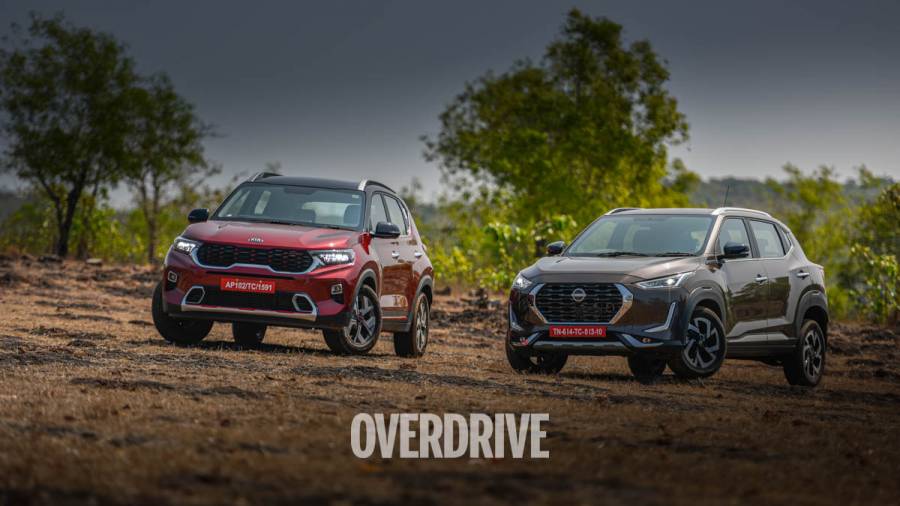
Coming to details that we liked on the two newest compact SUVs, and that you may like too, the Kiger's deeply scalloped hood, and beautiful sculpting in the tail gate around the tail lights stand out, while the designed-for-Datsun grille on the Magnite actually gives it a touch more street presence. On the Sonet, it's got to be the bulging hood, detailing in the bumper and the squared-off, Robocop-look to its tail lights, and for the Brezza, its updated twin-pod LED element headlights strike quite the image. Of the wheel designs (all four run 16-inch alloy wheels in top-spec), the Sonet's design suits the car the best, the Magnite's are the most eye-catching, the Kiger's look a little too art-deco, and the Brezza's are inoffensive. The Kiger and Magnite run narrower 195/60 section tyres, versus the 215/60 section rubber for the other two, which shows in the handling characteristics as we'll see later.
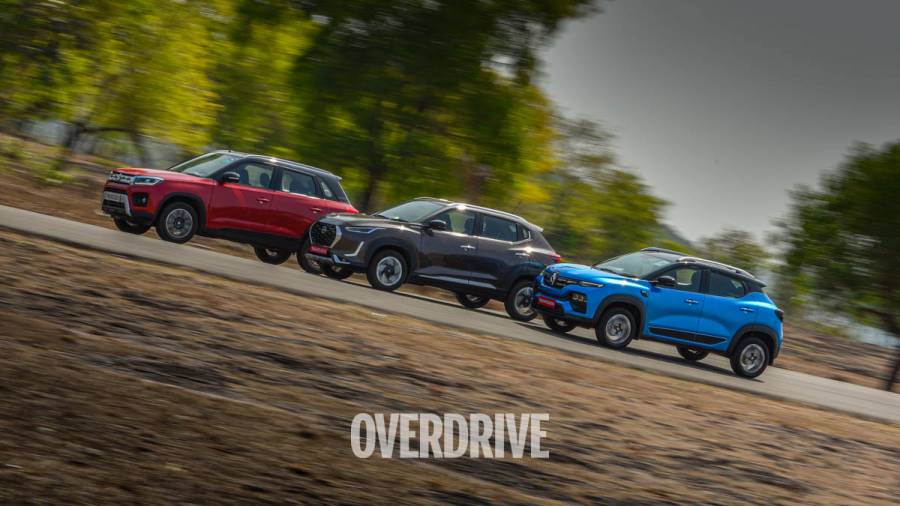
Renault Kiger vs Nissan Magnite vs MS Vitara Brezza cabin, features and practicality
Being cut from the same cloth and all, you'll find a bunch of common touch points (touchscreen, climate controls, stalks, basic IRVM etc) between the Kiger and Magnite, though overall, the Kiger does have just a little more polish to it, in the form of noticeably better quality upper dash plastics, more gloss black trim and artificial leather arm rests on the door pads. It's actually enough of a difference, especially in the way interior panels fit together, to elevate the experience enough to close the gap to the Sonet! It is relative, of course. The extra effort that has gone into the Sonet soon makes itself obvious, and it does feel special but it does have its own caveats, which we'll get to.
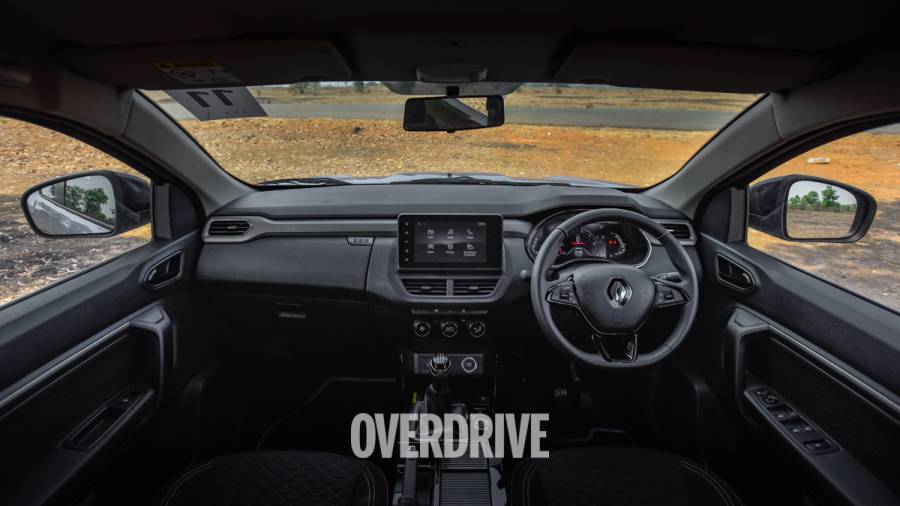 Kiger's all-black interiors offer a multitude of storage options
Kiger's all-black interiors offer a multitude of storage options
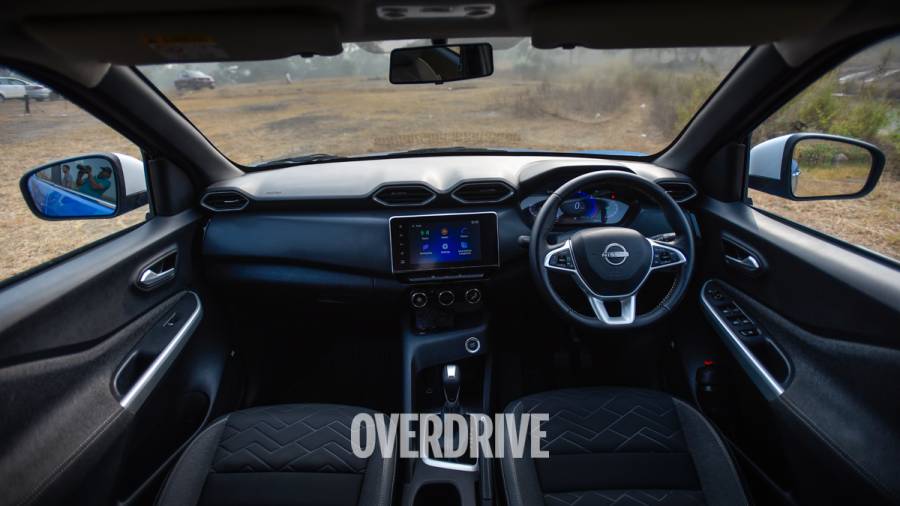 Magnite's dash a little more driver-centric, and large fabric sections on door pads help break up the plastic monotony
Magnite's dash a little more driver-centric, and large fabric sections on door pads help break up the plastic monotony
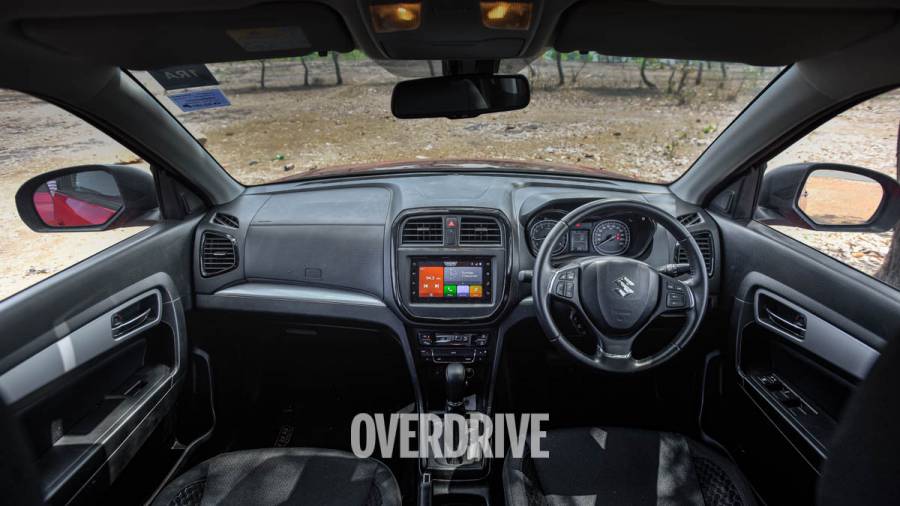 Comfortably familiar cabin on the Brezza verges on too utilitarian now
Comfortably familiar cabin on the Brezza verges on too utilitarian now
In fact, the first impression gleaned from looking at the instrumentation puts the Kiger out ahead of all the rest - it's fully-digital instrumentation has been executed nearly to perfection! The dials change with the drive mode selected, a first for the segment. And while the Tata Nexon does offer drive modes as well (but wasn't available for this test), nothing else comes close to this level of sophistication for the price. Other than the Kiger's vastly better executed dials, the information you receive is on par with the Magnite, while the Brezza's digi-analogue layout looks decidedly basic now. Strangely, this is one area where the Sonet trails the Alliance cars, offering a basic-looking speedo that looks a little juvenile, rather than young and fresh.
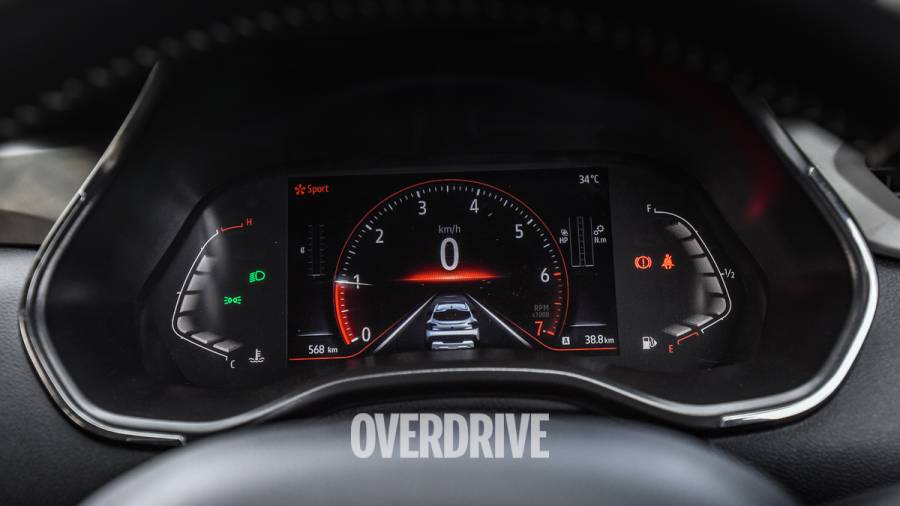 Sport mode the only one which offers a tacho on the Kiger, but includes a g-force meter, and horsepower and torque graphs
Sport mode the only one which offers a tacho on the Kiger, but includes a g-force meter, and horsepower and torque graphs
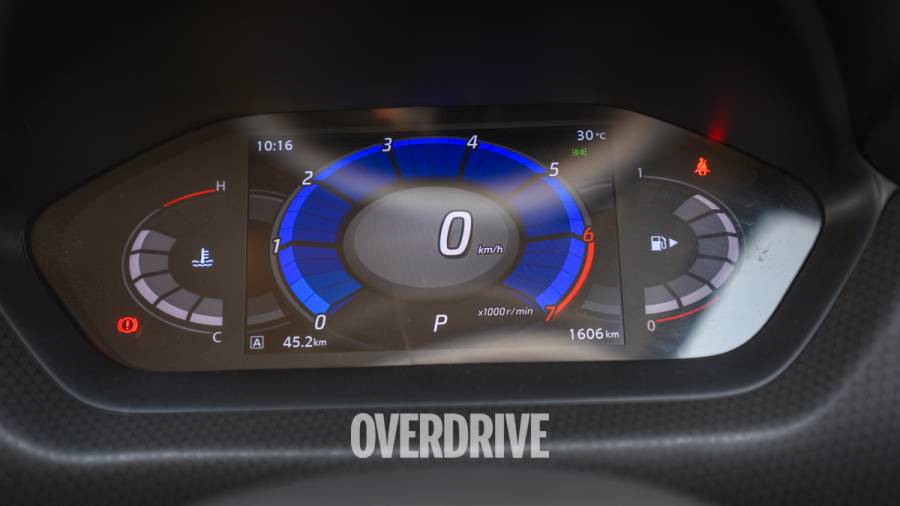 Magnite's colourful instrumentation not to everyone's taste but is very clear and legible
Magnite's colourful instrumentation not to everyone's taste but is very clear and legible
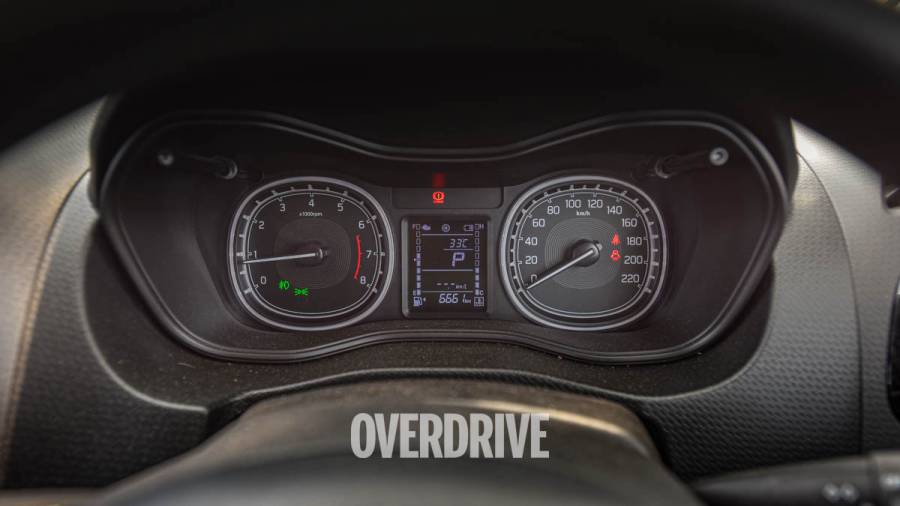 While you can change the colour of the dial outlines in the Brezza, the basic MID leaves room for improvement
While you can change the colour of the dial outlines in the Brezza, the basic MID leaves room for improvement
Coming to the space on offer, the Kiger and Magnite do a surprisingly good job, with flat-ish but still comfortable seating, front and rear, though the lack of a dead pedal for the driver to rest his foot on in the manual variants is a massive sore point. The CMF-A+ platform they share has its advantages, in a flat floor, and enough width to squeeze in three adults for shorter distances, in relatively more comfort than the Sonet. That being said, both can't quite match the Brezza for a roomy rear seat, though the angle of recline on the Kiger and Magnite, being near identical, is more relaxing. If you're looking for the most space, the Brezza will probably serve you well, though as we've seen it isn't the most comfortable, or special-feeling, cabin to spend a long distance in, at least not any more. The Sonet feels a touch smaller, especially when it comes to elbow room in the front, but it does feel the most luxuriously put together for obvious reasons. Left parked in the sun, the Kiger, Brezza and Sonet's cabin cool the quickest on start-up, with the Sonet's ventilated seats being a massive boon, while the Magnite's lowest temp setting of 19 degree celsius can't quite seem to cut it, needing over 5-10 minutes to cool down properly.
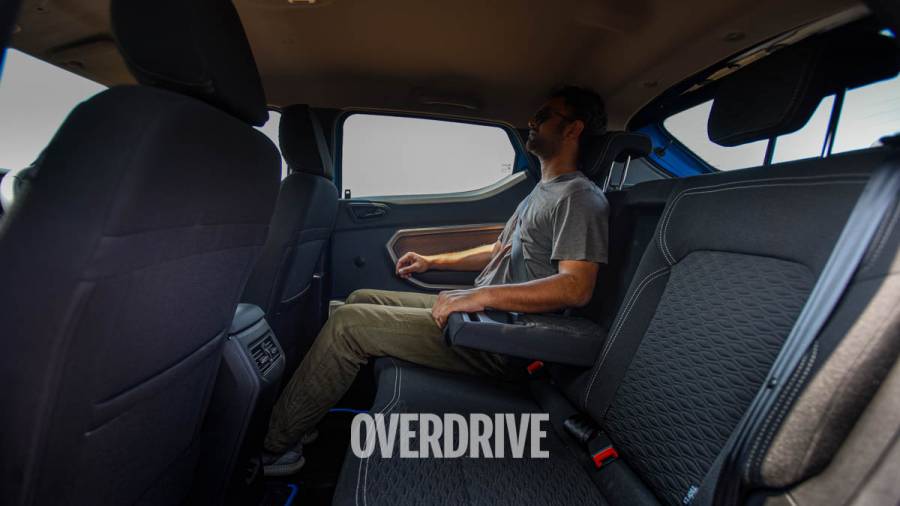 Kiger's rear bench a comfortable place to be, with more than adequate kneeroom and under thigh support
Kiger's rear bench a comfortable place to be, with more than adequate kneeroom and under thigh support
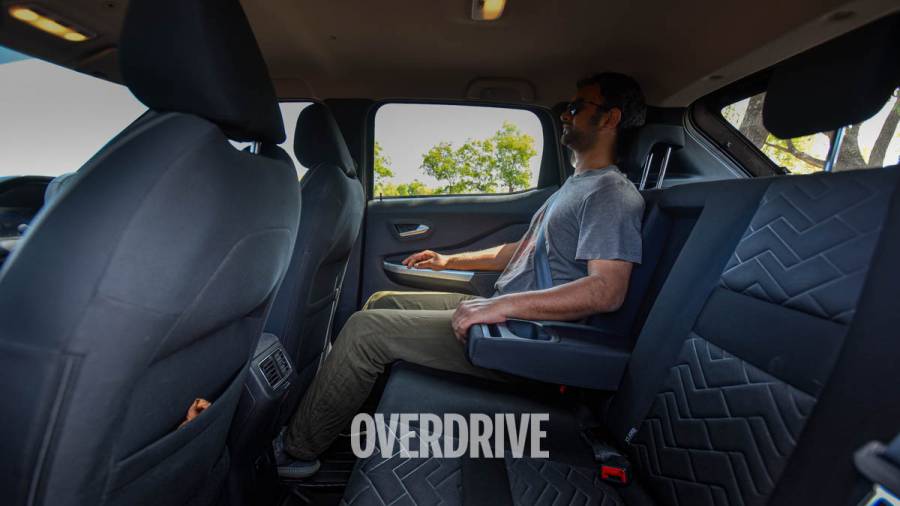 Nearly indentical is the Magnite's rear bench, with a marginally more square rear window helping the impression of space
Nearly indentical is the Magnite's rear bench, with a marginally more square rear window helping the impression of space
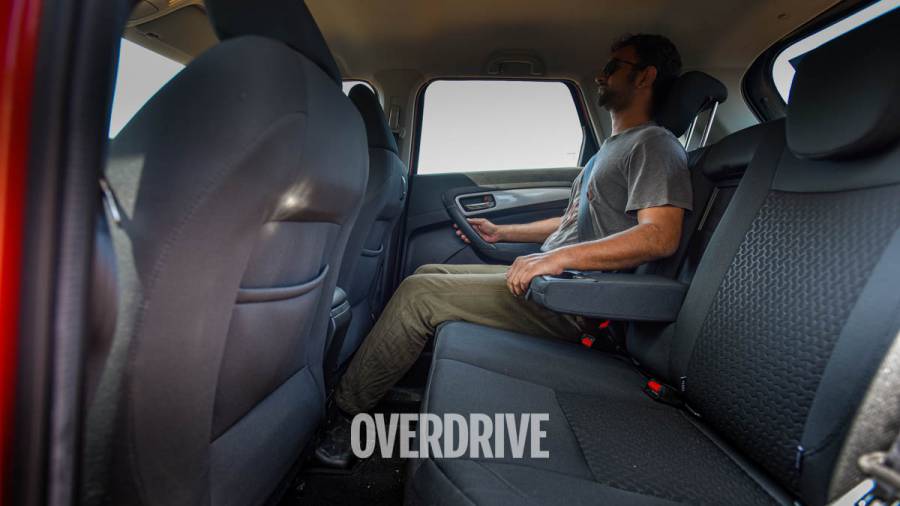 The Brezza's seat back a little more upright than the other two, but overall space marginally more than the Alliance SUVs
The Brezza's seat back a little more upright than the other two, but overall space marginally more than the Alliance SUVs
The Kiger also does seem to have had the advantage of learning from what the other have done, with space optimisation at an all-time high, with a level of central tunnel storage we've only previously seen in more expensive cars - the sliding gloss black panel hiding a removable cup holder liner, with notches for smaller items as well. Except for the Brezza, all have wireless phone charging, though the Alliance cars take that further with full wireless Apple CarPlay/Android Auto functionality. Both do have, for the lack of a better word, cheap feeling inner rear view mirrors, with manual glare toggles. Neither offer auto headlights or wipers, something that the Sonet offers, while the Brezza has the former. As for standout features, the Sonet does have ventilated seats, a Bose sound system and the option of a sunroof, the Magnite has a 360-degree camera and JBL audio, the Kiger has switchable ambient lighting and Arkamys audio, while the Brezza now offers an auto-dimming IRVM.
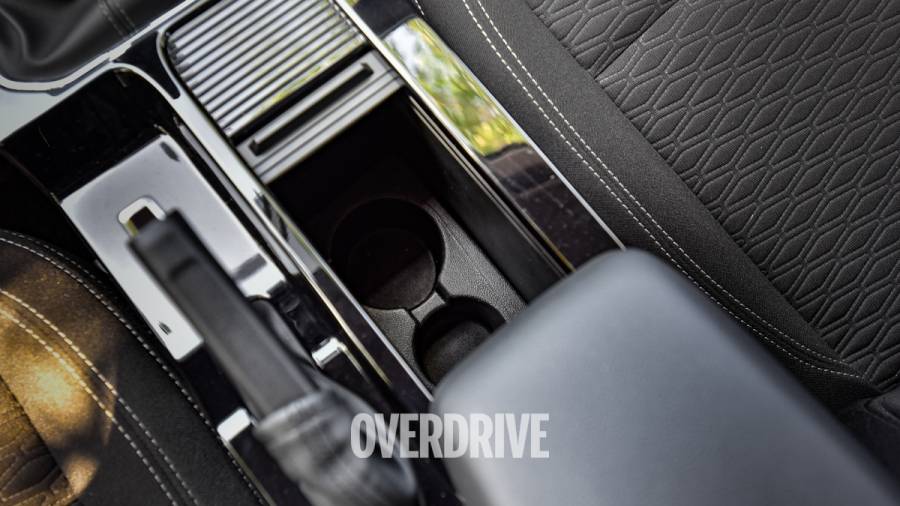 Covered central storage in Kiger not something you usually see in this price point. It's well thought-out too!
Covered central storage in Kiger not something you usually see in this price point. It's well thought-out too!
Surprisingly again, the Kiger has the most boot space at 405-litres, though it isn't apparent to the naked eye, seeming near identical to the Magnite's 336-litres. The Kiger doesn't have a full boot lining, which may contribute a few centimetres to the overall dimensions, if at all, though it does have a higher loading lip and as a consequence a deeper boot, though the Sonet does come very, very close at 392-litres of space. The Brezza has the least boot space at 328-litres, but its rear seat squabs also cantilever away for a full-flat loading floor once you fold the rear seat backs down.
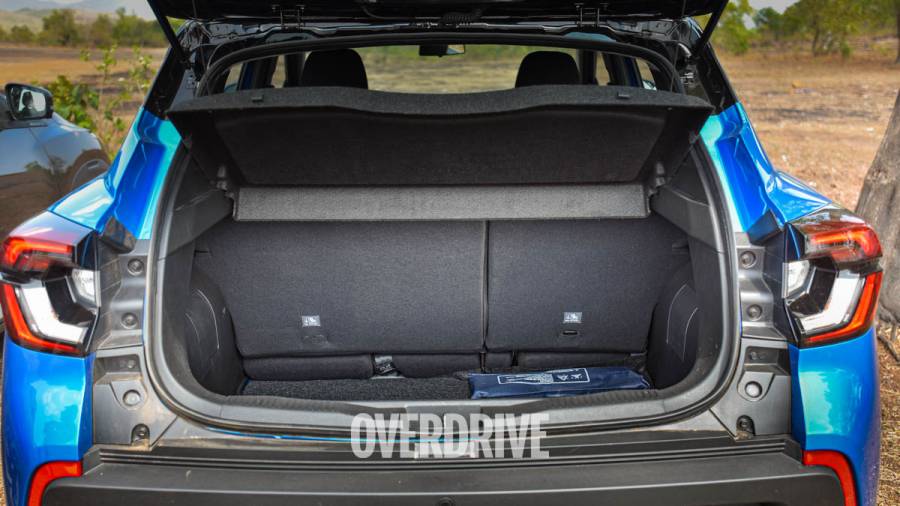 Kiger's boot has a higher loading lip than identically-shaped Magnite...
Kiger's boot has a higher loading lip than identically-shaped Magnite...
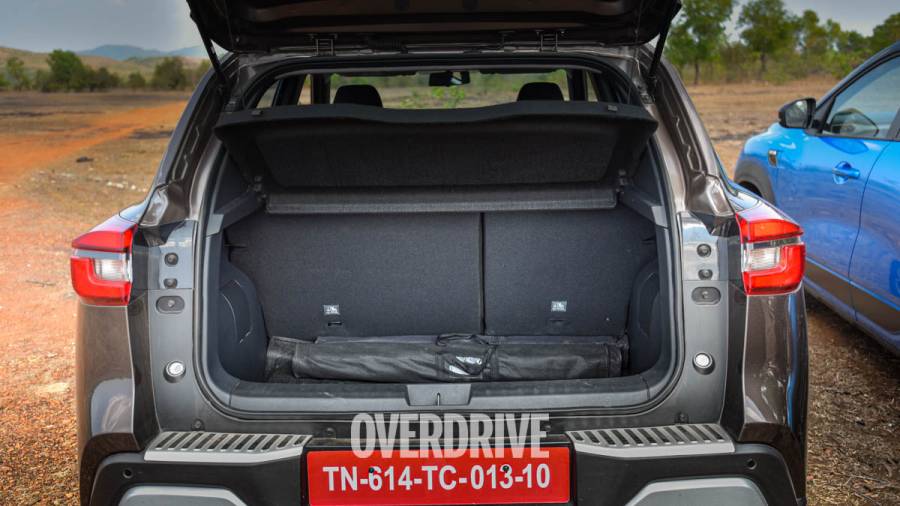 ... which may explain its 405-litres versus the Magnite's (seen here) 336-litres of cargo space
... which may explain its 405-litres versus the Magnite's (seen here) 336-litres of cargo space
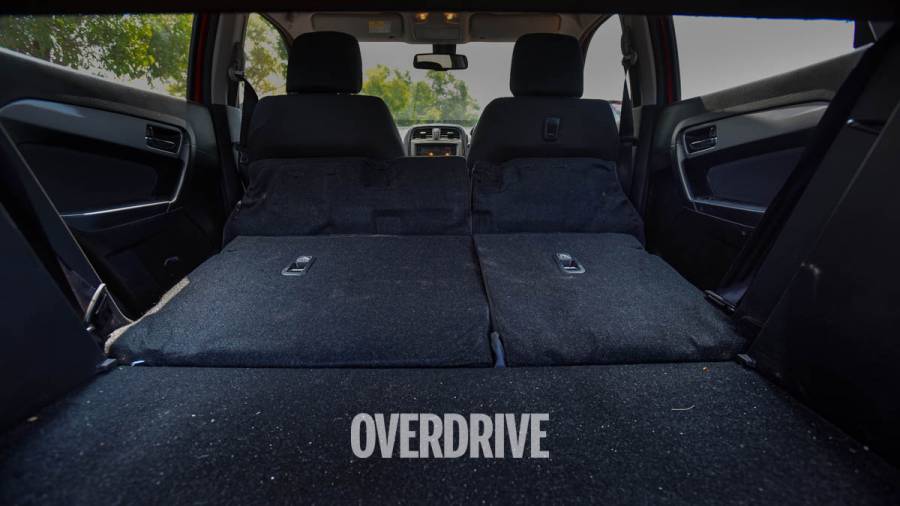 Brezza's 328-litre boot comes in last, but has a tumble rear bench that allows for a fully flat loading floor
Brezza's 328-litre boot comes in last, but has a tumble rear bench that allows for a fully flat loading floor
Renault Kiger vs Nissan Magnite vs MS Vitara Brezza safety features
Straight up, the Kiger and Sonet haven't been crash tested yet, while the Magnite has earned a 4-star ASEAN NCAP rating, and the pre-facelift Brezza a 2-star Global NCAP rating. Credit where it's due, Renault offers the Kiger with four airbags on the top two variants, while the Magnite and Brezza top out at two airbags each. The Sonet offers six airbags, but only on GT-variants right at the top which forces us to reevaluate its safety feature scoring considering what the Kiger offers at the price. The Sonet gets traction control and an electronic stability control (ESC/ESP) system, the Magnite (all variants) get traction control, the Kiger turbo manual doesn't, and neither does the Brezza. As for parking aids, it's a bit of a toss-up - the Magnite has a 360-degree camera, the Kiger and Sonet have front parking sensors as well, while the Brezza only has the rear camera and sensors.
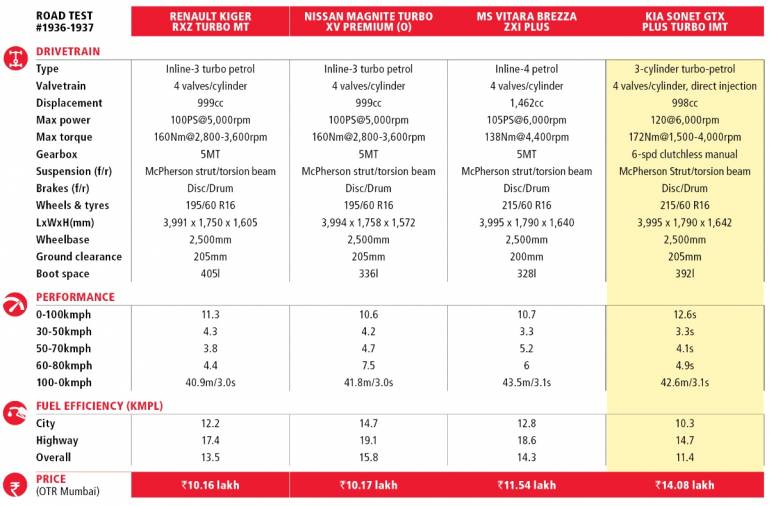
Renault Kiger vs Nissan Magnite vs MS Vitara Brezza engine, performance and efficiency
Largely down to circumstance and availability (some rivals just weren't available for this test) but indicative of the range of choice, on this test we've focussed on the Kiger and Magnite in their 1.0-litre turbo-petrol iteration, with a 5-speed manual, though we do recommend the CVT-variants for that gearbox's superiority in overall drivability and smoothness. The Sonet also packs a 1.0-litre turbo-petrol, with an iMT clutchless manual gearbox, and the Brezza has the largest displacement motor here, a 1.5-litre naturally aspirated petrol, mated to a 5-speed manual.
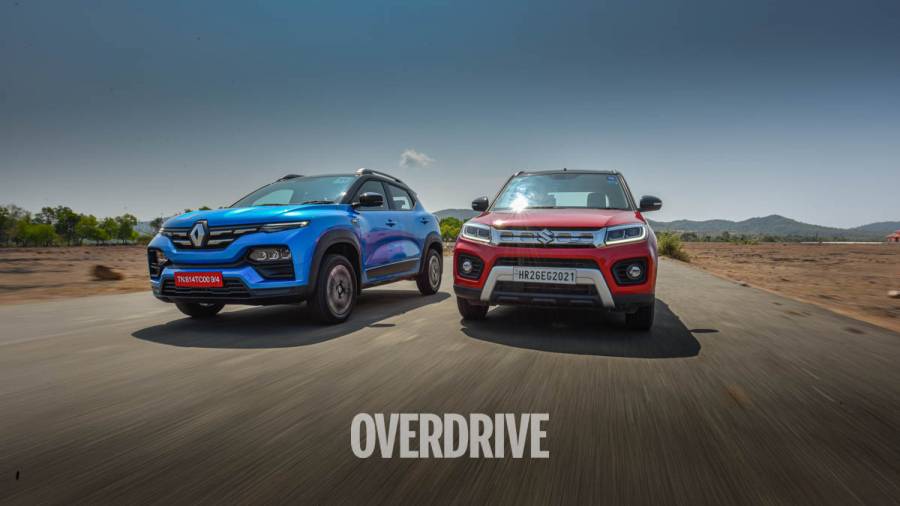
Reinforcing how good small-capacity turbocharged engines are now, the Brezza's got the least torque of the bunch! At 138Nm, it's a fair bit down on the Kiger and Magnite's 160Nm, and the Sonet's 172Nm. The Sonet makes the most power, a 120PS, compared to the Brezza's 105PS, and the Kiger/Magnite's 100PS. Continuing with the numbers theme, the Magnite posted the quickest 0-100kmph timing at 10.6s, though the Brezza also manages an identical 10.7s! These are followed by the Kiger at 11.3s, the Sonet iMT at 12.6s. The minuscule difference to the Kiger is surprising, but without traction control there is substantial time-sapping wheelspin, while the Sonet iMT doesn't allow for the most aggressive gearshifts.
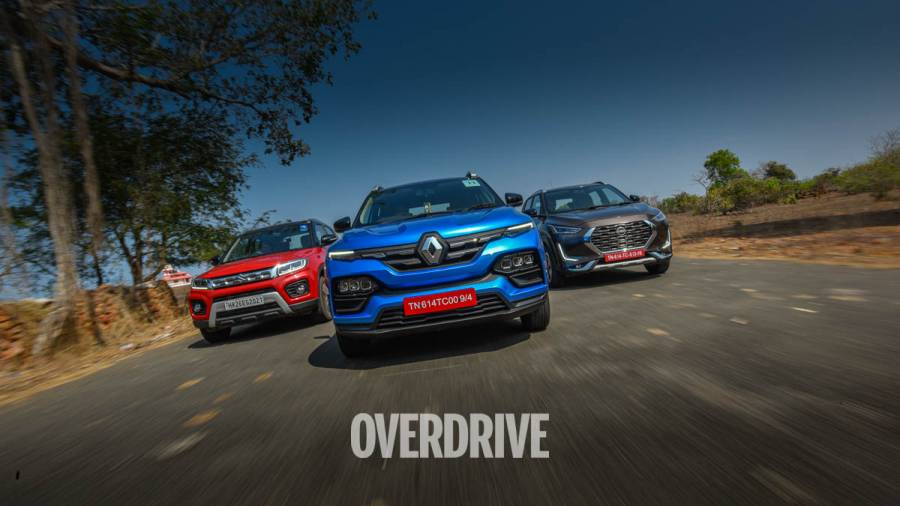
While we don't have official kerb weight figures for the Kiger, the Magnite MT weighs 1,014kg, which should be closely matched by the mechanically identical Kiger. This helps explain the performance versus the heavier Sonet with its clutchless manual (exact figures not confirmed but Turbo variants should be in the mid-1,100s), while the Brezza weighs in at 1,130kg.
With that out of the way, the Kiger also feels the most energetic in the city, with seemingly less turbo lag than the Magnite, and a stronger shove in the back in its Sports drive mode. The Kiger's power delivery feels a lot more linear in Normal, but completely deadened in Eco - it's not a mode I'd recommend you try often unless you're a very new driver who prefers a slow-reacting throttle. The 1.5-litre in the Brezza feels the most effortless in the city at low revs, happy to take speed breakers in second, but needs a downshift for higher speed overtakes. On the other hand, the turbo engines on the others feel a little lifeless under 1,800rpm but are usually in the meat of their powerband at highway cruising speeds making for near effortless overtakes.
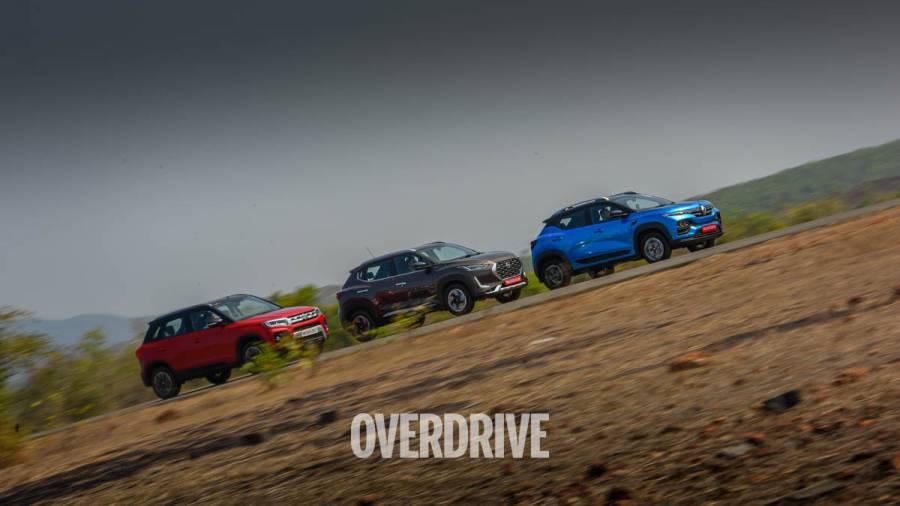
The Brezza, and Sonet iMT, are a second quicker than the Alliance twins in 30-50kmph in third gear pulls, highlighting its tractability, but loses that advantage as speeds rise. The Kiger, in its Sports drive mode, is substantially quicker than the Magnite, Brezza and even Sonet in 50-70kmph pulls in fourth gear, and like we said, you'll feel less of that turbo lag than its turbo'd peers.
In the fuel efficiency charts, the Magnite turns out to be the most fuel efficient, posting an overall 15.8kmpl, followed by the Brezza at 14.3kmpl, the Kiger at 13.5kmpl and the Sonet at 11.4 kmpl, despite its 6-speed iMT.
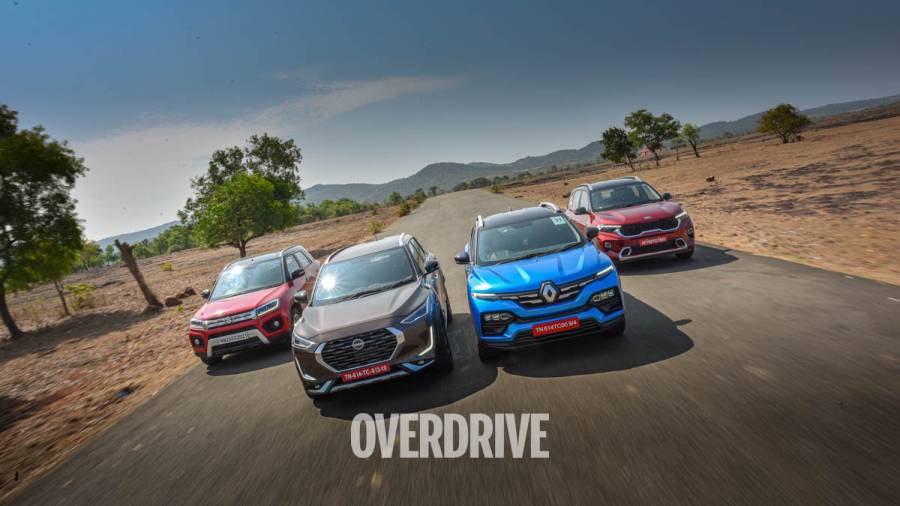
Speaking of NVH, the Kiger feels a little more refined than the Magnite though both have vibrations at idle that creep up through the floorpan, while the Kiger does suffer from a bit of drivetrain lash that you can feel through the gear shift lever. As far as gearboxes go, the Kiger and magnite's 5-speed manual feels a little notchy between shifts, and the long travel of the clutch pedal is something you'll have to get used to in traffic. The CVT on these cars is perfectly tuned for this engine, keeping it in the power but not feeling like it's always straining at the leash either, nor does it go into an aggressive coast when you're off throttle in its Sport mode. It's the gearbox we'd recommend. The Brezza's 5-speed feels smoother between the gate, and has a more natural feeling clutch action, aside from being less work in traffic. As for the Sonet, the iMT is effortless, well, apart from having to make shifts yourself, and is a great way to reduce some of the fatigue associated with driving a manual in traffic.
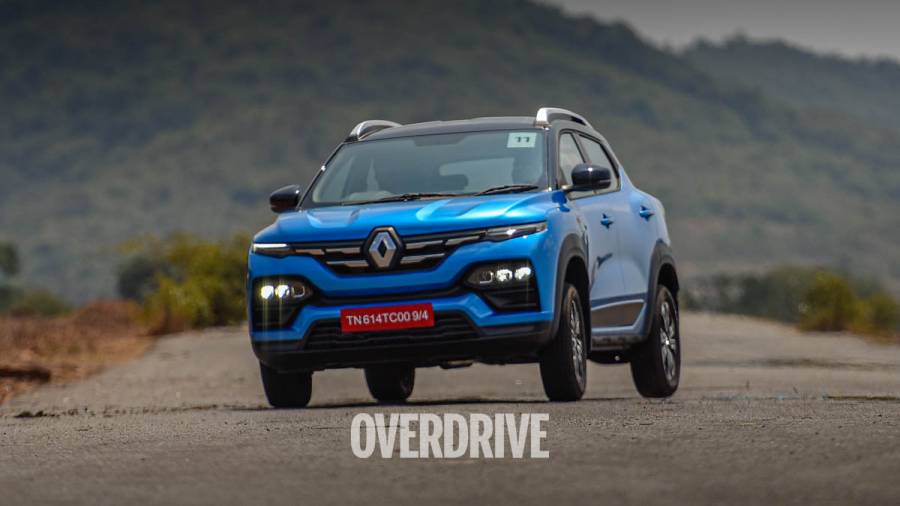
Renault Kiger vs Nissan Magnite vs MS Vitara Brezza ride and handling
All these compact SUVs run McPherson strut front setups, and torsion beam rears and all offer varying degrees of ride comfort, though they all are placed quite near on the 'comfort' side of the spectrum. The Kiger and Sonet seem to balance bump absorption and body control the best, while the slightly-stiffer setup on the Magnite can feel a little unsettled (and noisy) over a set of rumble strips, as does the soft Brezza which will also tends to get thrown about a bit over the rough stuff. For most buyers, where driving it in the city will take precedence, the Kiger would appear to be the better choice over the Magnite and Brezza for ride comfort, with a slight edge going to the Sonet which rounds off bumps with a little more aplomb.
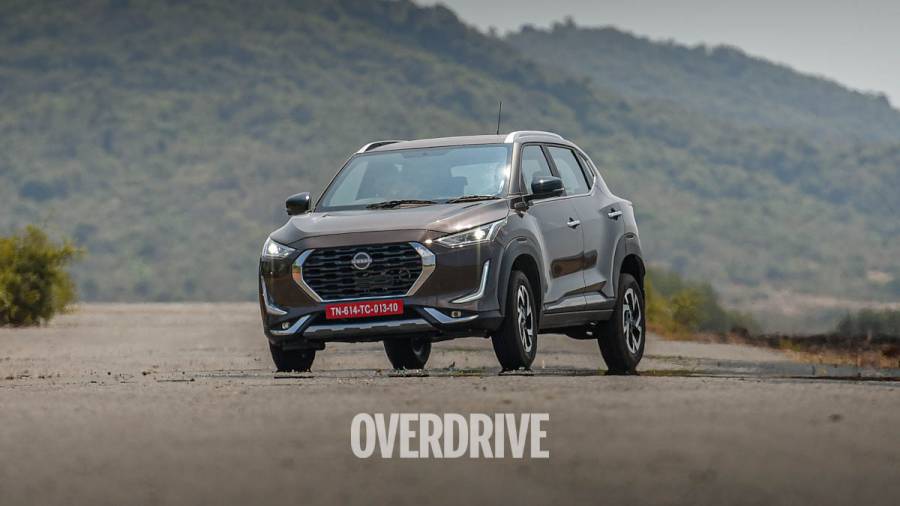
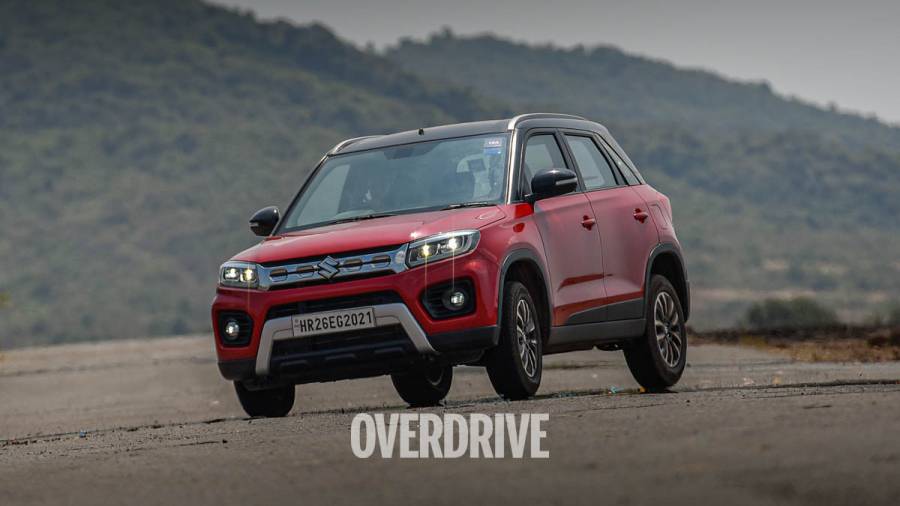
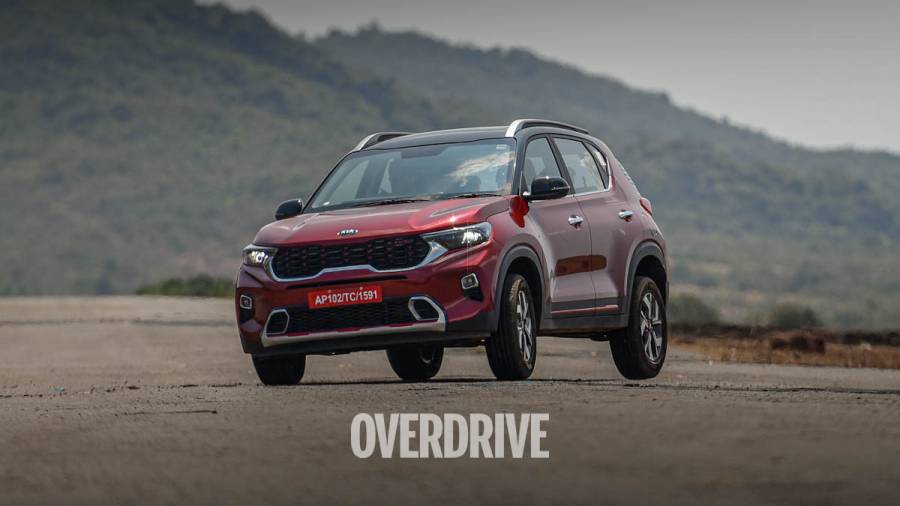
If you're looking for a sporty handler, the Magnite does have the stiffest suspension setup but suffers from an inconsistent feel from its steering, ranging from heavy at low speeds, to heavier still in corners, but making you feel a little unsure about its limits. The Kiger largely fixes that with its drive modes, with its Sport mode affecting steering feel as well, putting it right up there at the top despite the softer setup. Though, both the Alliance cars do feel under-tyred and tend towards understeer with quite a bit of roll under hard cornering. The Sonet, offers better feel from its steering but also dives into corners, while strangely the Brezza leans into corners but settles on its springs to stay a little flatter than the rest through the turn, despite its steering not giving you the greatest level of confidence thanks to its slightly over-reactive rack.
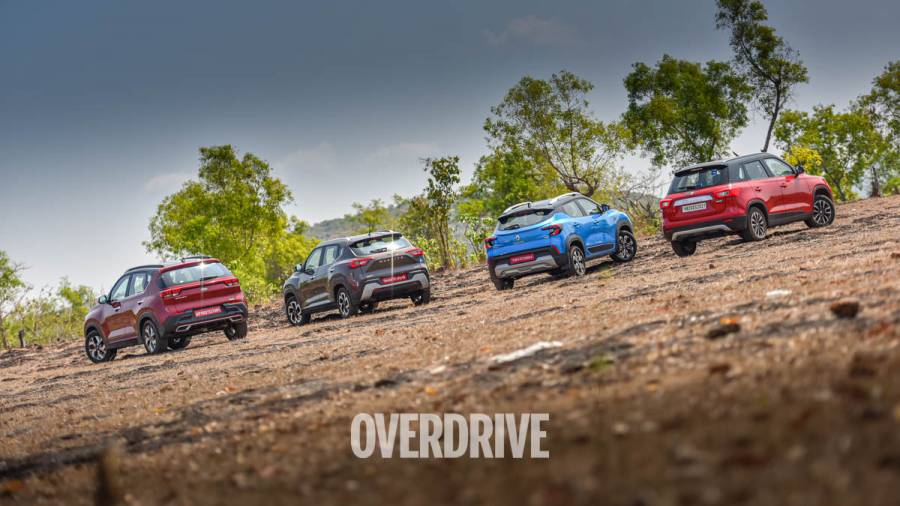
Renault Kiger vs Nissan Magnite vs MS Vitara Brezza verdict
All things considered, between the nearly identically priced Kiger and the Magnite, the Renault pulls out ahead for offering just a little more polish to its interiors, and its instrumentation, while the addition of drive modes that aren't gimmicky is truly surprising at its price of Rs 10.16 lakh (on road, Mumbai). The couple of extra airbags also add value quite dramatically, though overall comfort and space is understandably identical. The Brezza, at Rs 11.54 lakh (ONR, Mumbai) has started to show its age, and while it used to be quite impressive, the fact that it set benchmarks means that the newer bunch could come along and just do it a little better, and at a better price as is now evident, though overall space is still the best in the Brezza, further backed by Maruti Suzuki's strong after-sales network. Meanwhile, the Sonet is clearly the most polished out of the lot, with a heavy suite of features but it does come at a hefty price of Rs 14.08 lakh (ONR, Mumbai) that could be worth it if you're a stickler for sophistication. For most, and not just the value conscious buyer, the Kiger seems like it would tick the boxes that matter most, as is evident by just how close it comes to the more expensive Sonet in our points table.
Photography by Anis Shaikh
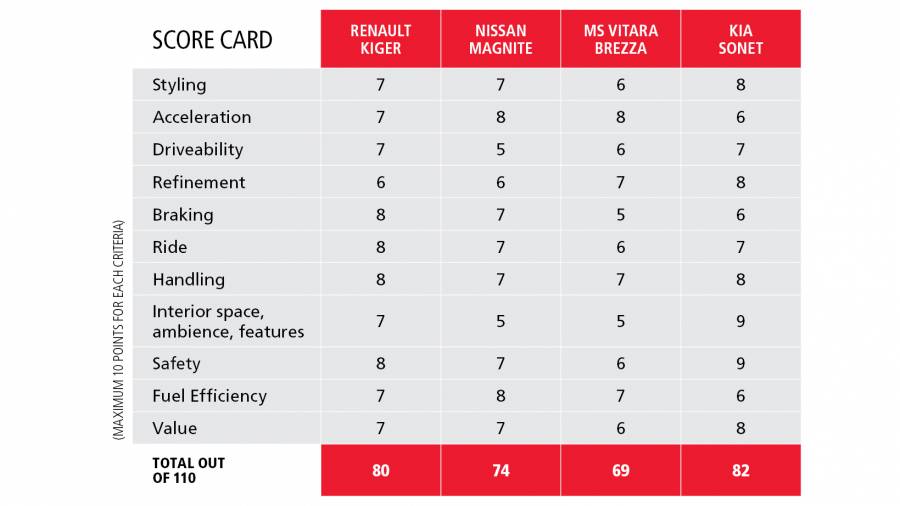
Starts Rs 6.71 Lakhs
1493cc
Automatic
83
250
-NA-
Starts Rs 5.59 Lakhs
999cc
CVT
72
152
17.7 Kmpl
Starts Rs 5.45 Lakhs
999cc
CVT
72
152
-NA-
Starts Rs 7.34 Lakhs
1462cc
Automatic
-NA-
138
18.76 Kmpl
Starts Rs 6.95 Lakhs
1497cc
Automatic
110
260
21.5 Kmpl
